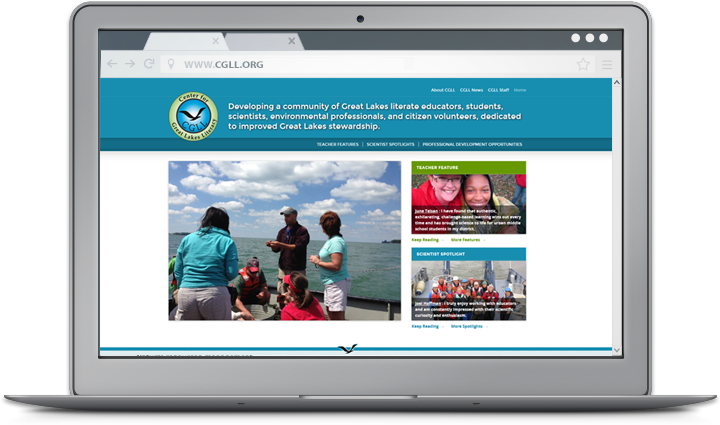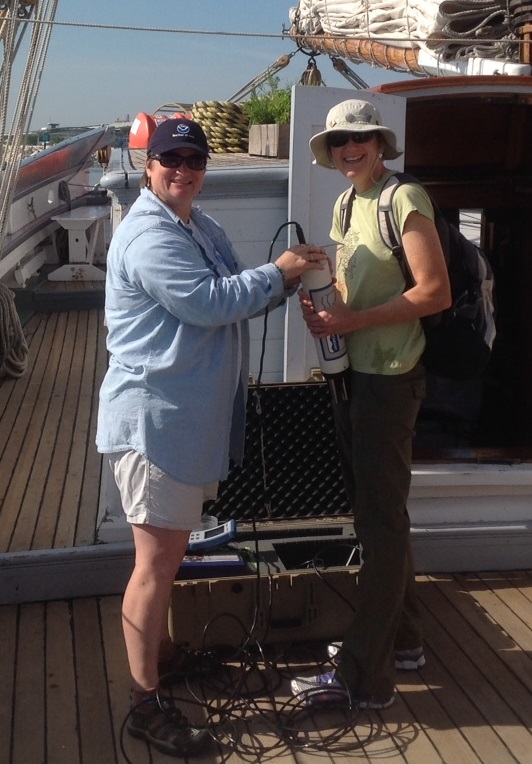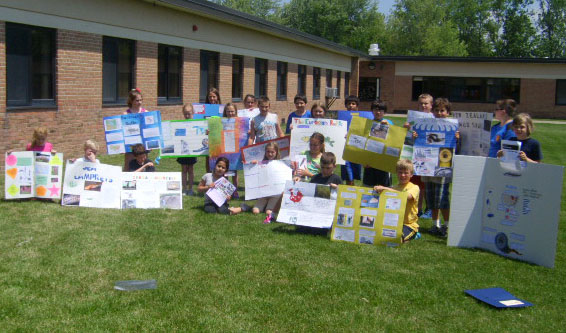A new version of the award-winning curriculum The Medicine Chest is now available! This updated and revised version includes new lessons and new teaching approaches. Here’s the story of how this edition came to be.
Category:
Hey educators! The Medicine Chest has a new look and new lessons
November 5th, 2015 by iisg_superadminNature is right down the street for East Chicago students
May 18th, 2015 by iisg_superadminIt was a chilly May 12th, cloudy and windy as well. But 29 sixth graders from West Side Middle School in East Chicago, Indiana came to nearby Roxana Marsh to experience what the outdoors has to offer, learn new things, help with the cleanup and restoration of the natural area, and enjoy the afternoon.
Roxana Marsh is part of the larger Grand Calumet River Area of Concern, which has been undergoing dredging through the Great Lakes Legacy Act over the past six years. The marsh section of the project was completed three years ago with the removal of 600,000 cubic yards of sediment.
This accomplishment was celebrated with a press event attended by government officials and local school children. Those middle schoolers left their legacy in perennial plants that are now thriving along the marsh. This year’s class is the third group of gardeners in what may well become an annual tradition.
In addition to planting natives, the students learned the basics of birding, explored the small community of life in sediment, and manned trash bags for garbage detail. There were water beetles, egrets, killdeer, toads, dragonfly nymphs, and more to experience.
Throughout their afternoon tour, the 6th graders were guided by experts from Audubon Chicago Region, U.S. EPA, The Nature Conservancy, Shirley Heinz Land Trust, Indiana’s departments of Natural Resources and Environmental Management, Northwest Indiana Regional Planning Commission, Dunes Learning Center, and Illinois-Indiana Sea Grant.
Last June, she took part in a one-day workshop at Purdue University Calumet, which introduced the Helping Hands curriculum to 25 local educators. Helping Hands activities are ideally suited to schools in Areas of Concern that are going through the cleanup process—they provide opportunities to directly engage students in the larger project. The workshop also included a visit to several sites on the Grand Cal to see the dredging work in progress as well to walk around a finished site—Roxana Marsh.
 “The cleanup and restoration of the Grand Calumet River is brightening the northwest Indiana landscape,” she explained. “This work transforms space into places that students can visit, perform stewardship work, and develop pride in their local environment. Environmental educators teach students that nature is in their backyard, but for these students, high quality nature is in their backyard, right here in East Chicago, Indiana.”
“The cleanup and restoration of the Grand Calumet River is brightening the northwest Indiana landscape,” she explained. “This work transforms space into places that students can visit, perform stewardship work, and develop pride in their local environment. Environmental educators teach students that nature is in their backyard, but for these students, high quality nature is in their backyard, right here in East Chicago, Indiana.”Website of the week: A one-stop-shop for Great Lakes educators
January 14th, 2015 by iisg_superadminA closer look at web tools and sites that boost research and empower Great Lakes communities to secure a healthy environment and economy.
.png) Educators interested in strengthening aquatic science programs and encouraging Great Lakes stewardship—look no further than the new Center for Great Lakes Literacy (CGLL) website.
Educators interested in strengthening aquatic science programs and encouraging Great Lakes stewardship—look no further than the new Center for Great Lakes Literacy (CGLL) website.
Created by Sea Grant educators throughout the region, the site is a one-stop-shop for classroom activities designed to boost Great Lakes literacy. Educators will find information on and links to teacher-tested curriculum like Fresh and Salt and Estuaries 101. And the Teacher Feature allows visitors to hear about education success stories directly from colleagues across the region.
Visitors to the site can also learn about the latest professional development opportunities available throughout the region. For example, teachers interested in the annual Shipboard Science Workshop, held this year on Lake Michigan, can find workshop information and application deadlines. Featured blogs also make it possible to read about teacher experiences at past CGLL workshops and follow along with the latest projects.
For more information on upcoming educator workshops and available curriculum, contact Terri Hallesy.
Wisconsin teachers make the most of Sea Grant aquatic education opportunities
January 13th, 2015 by iisg_superadminReal-world, hands-on activities are bringing Great Lakes science alive for a group of Wisconsin middle school students. Our friends at Wisconsin Sea Grant have the story.
Two Wisconsin teachers have made exceptional use of the educational resources that Sea Grant has to offer. And not just resources from Wisconsin Sea Grant—the teachers have found valuable support from the Center for Great Lakes Literacy, a collaborative effort by educators in the Great Lakes Sea Grant Network funded through the Great Lakes Restoration Initiative.
The teachers are Lynn Kurth and Cindy Byers. Kurth works as a science teacher for Prairie River Middle School in Merrill, Wis. Just a 50-minute drive away, Byers works as a science and reading teacher for Rosholt Middle School in Rosholt, Wis.
They met in 2011 during a week-long voyage on the Lake Guardian, a research vessel owned by the U.S. Environmental Protection Agency (EPA). They were participating in a Shipboard and Shoreline Science Workshop, a program conducted by the Great Lakes Sea Grant programs through the former Centers for Ocean Sciences Education Excellence (which has become the Center for Great Lakes Literacy). They were part of a team of five colleagues who worked on a research project together. Kurth and Byers bonded over a Hydrolab—a large, tubular piece of water testing equipment—and it’s led to bigger and better things for both them, their students, and other teachers across the country.
The Hydrolab takes various water quality readings. Kurth and Byers were drawn to it because both of their schools are near rivers and the EPA was providing the device on loan for use with their classrooms after the cruise. They saw the opportunity to partner in the future.
It worked. “We supported each other’s teaching and enriched each other’s classrooms by having this collaboration,” Byers said. “We had the kids Skype with each other a couple of times and present the Hydrolab data they collected. Even though our schools are not that far apart, it seemed quite exotic to the kids and they were excited to use a piece of equipment that scientists use. A lot of the reasons we’ve been able to do so much with the program is that we’ve been supporting each other all along.”nce-in-a-lifetime learning experiences for students. In fact, 26 classes across the Great Lakes region took a break from their regular activities over the last year to video chat with the scientists behind the EPA Lake Guardian‘s annual monitoring cruises. Some students even took a guided virtual tour of the boat.
And now a new group of teachers and non-formal educators have an opportunity to work with Sea Grant specialists to introduce activities like these into their aquatic sciences sections during the 2015 Shipboard Science Workshop on Lake Michigan. Applications for the 15 available spaces are due February 10.
Place-based education inspires more than just students
November 24th, 2014 by iisg_superadminStewardship and place-based education are nothing new to us educators at Illinois-Indiana Sea Grant. In fact, the IISG education team has been leading efforts in these initiatives throughout southern Lake Michigan communities for years. For this reason, going into the conference, I thought it was a great opportunity for us to share our models of stewardship and place-based education. I didn’t plan on gaining much insight into how and why these objectives were critical. Boy, was I wrong.
The opening keynote address by Kim Rowland, a middle school science teacher, detailed how her students have been able to use their surrounding environment in Grand Rapids as a resource for exploration and learning. What was most captivating and exciting to hear was how this time spent investigating the outdoors was a way to reach students that are not typically high academic achievers. Kim told us about a particular student who was always getting in trouble—not wanting to come to school, and certainly not excited about learning. Though she had not anticipated this, venturing out to the stream on school property transformed him into the most enthusiastic student of the group. In fact, this student was now so interested in collecting samples that he waded even further into the stream, thus giving Kim a very fitting title for her presentation: “Getting Your Feet Wet and Allowing Water to Flood Your Boots.”
Nab the Aquatic Invader! now a one-stop-shop for AIS projects
September 16th, 2014 by iisg_superadminOur education team is at it again! Allison Neubauer wrote in with this exciting announcement:
 Teachers across the Great Lakes region—have we got a treat for you! You can now explore creative projects from all-star educators to spark new ideas and read important tips for getting your students involved in the effort to “nab” local aquatic invaders.
Teachers across the Great Lakes region—have we got a treat for you! You can now explore creative projects from all-star educators to spark new ideas and read important tips for getting your students involved in the effort to “nab” local aquatic invaders.Community stewardship projects like the ones highlighted here are an exceptional tool for pushing students beyond rote memorization and providing them with an opportunity to apply their knowledge in ways that have positive impacts on their communities.
Preview outstanding examples of student work, ranging from fun informational activity books to catchy musical compilations. When you’re done perusing, read the summary reports written by the teachers responsible for these successful activities for information on how to plan and implement similar projects in your own classroom.
Science teachers get new curricula, activities, and more at ISTA conference
November 1st, 2013 by Irene MilesThe Illinois Science Education Conference, recently held in Tinley Park, featured more than 150 presentations, symposiums, and exhibits aimed at providing resources and professional development opportunities for science teachers throughout the state. Illinois-Indiana Sea Grant’s education team was among the many exhibitors participating, and offered materials and presentations to help introduce Great Lakes literacy principles to the teachers present.
 IISG’s Robin Goettel and Terri Hallesy led two presentations to give teachers information and guidance on getting their students interested in Great Lakes science and stewardship. Several educational resources were also made available for the teachers to utilize in their classes.
IISG’s Robin Goettel and Terri Hallesy led two presentations to give teachers information and guidance on getting their students interested in Great Lakes science and stewardship. Several educational resources were also made available for the teachers to utilize in their classes. Anjanette and Corrie staffed two tables in the exhibit hall. One focused on AIS and featured “Nab the Aquatic Invader” information, invasive species watch cards, games, and suggested alternatives to releasing classroom pets into the wild (the HabitattitudeTM project). The second table focused on several different curricula and stewardship programs offered by IISG. CDs of Fresh and Salt and Greatest of the Great Lakes were available, as well as flash drives with The Medicine Chest and Sensible Disposal of Unwanted Meds. Teachers were very excited to receive these because they were so compact and comprehensive, with several asking if they could give a second one to their colleagues.
Two Great Lakes Restoration Initiative projects were highlighted in our displays – Great Lakes Organisms in Trade Initiative-Research, Outreach and Education and Undo the Great Lakes Chemical Brew.
Recent News
- Tomas Höök signing off as Illinois-Indiana Sea Grant director this summer
- Illinois-Indiana Sea Grant welcomes Stuart Carlton as the program’s new director
- Four Illinois and Indiana educators will set sail on Lake Michigan aboard EPA’s research ship
- Join IISG as a new pollution prevention outreach assistant
- Beach season means it’s time for lifesaving Lake Michigan water safety resources
IISG Instagram
The Shipboard Science Immersion educators worked together to simulate sonar mapping and uncover the secrets of a mystery seabed, just like real underwater archaeologists!
This hands-on lesson mirrors the work of Dr. Ashley Lemke from University of Wisconsin Milwaukee who studies paleo landscapes below Lake Michigan by collecting sonar data from lakebeds. Experiences like these can be shared with youth to spark curiosity and connect them to real-world science in action.
#LakeMichigan #GreatLakes

15 educators from 7 Great Lakes states have boarded the R/V Lake Guardian for a week of science on Lake Michigan!
Day one was all about meeting fellow educators and the science team from the @epa_greatlakes, @uwmilwaukee, and @purduefnr, and getting shipboard safety training.
This hands-on program, supported by the Great Lakes Restoration Initiative, helps bring Great Lakes science into classrooms and builds educator-scientist partnerships.
Follow along as we explore water quality, food webs, and even underwater archaeology!
#GreatLakes #LakeMichigan

Ready for a party? Join us on the newly-expanded Wild Mile for a celebration of our urban waterways and thriving park spaces. Enjoy local beer, food trucks, and an outdoorsy prize drawing while learning about local environmental nonprofits and volunteer opportunities! This event is free and fun for all ages!
The block party is rain-or-shine, and we`ll only cancel in the case of hazardous weather!
This year’s community partners include @Openlands, Current Water, @chicago_enviro, @cleanupclub_chicago, @chicago_birder, Blazing Star School, @cubillinois, Friends of the Bloomingdale Trail, @chicagoshapers, @reducewastechicago, Southern Utah Wilderness Alliance, and @honeycombproject!
Learn more at the link in bio.

📢 Show Your Support for Sea Grant! 📢
Continued federal funding for Sea Grant in FY26 is crucial, and we need your help to demonstrate the nationwide support for these essential programs.
🖊️ Sign the letter urging Congress to continue funding Illinois-Indiana Sea Grant and all 34 state Sea Grant programs:
🔗 https://forms.gle/7sPGHGyh8j8a7vfGA or link in bio

Categories
- Aquaculture
- Aquatic Invasive Species
- Buoys
- Climate Ready Communities
- Director's Blog
- Education
- Featured
- Fellowships
- Fisheries
- Funded Research
- Funding
- Great Lakes Cleanup
- Great Lakes Data
- Healthy Waters
- Internships
- Jobs
- K-12 Education
- News
- Photos
- Program
- Recreation & Tourism
- Resources
- Sea Grant Scholars
- Stormwater & Green Infrastructure
- Sustainable Community Planning
- The Helm
- Uncategorized
- Video
- Water Resource Economics




.jpg)



